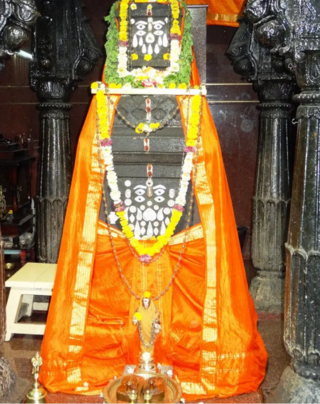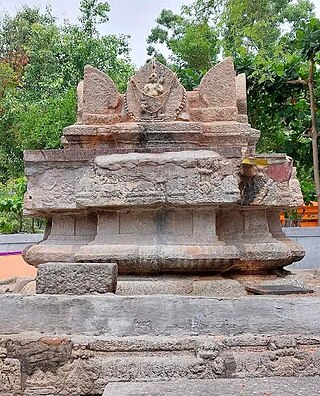Related Research Articles

Raghavendra Tirtha, also referred as Raghavendra Swami, was a Vaishnava scholar, theologian, and saint. He was also known as Sudha Parimalacharya. His diverse oeuvre include commentaries on the works of Madhva, Jayatirtha, and Vyasatirtha, interpretation of the Principal Upanishads from the standpoint of Dvaita and a treatise on Purva Mimamsa. He served as the pontiff of the matha at Kumbakonam from 1621 to 1671. Raghavendra Tirtha was also an accomplished player of the veena and he composed several songs under the name of Venu Gopala. His shrine at Mantralayam attracts lakhs of visitors every year.

Madhvacharya, and also known as Purna Prajna and Ānanda Tīrtha, was an Indian philosopher, theologian and the chief proponent of the Dvaita (dualism) school of Vedanta. Madhva called his philosophy Tattvavāda meaning "arguments from a realist viewpoint".

Sri Jayatirtha, also known asTeekacharya, was a Hindu philosopher, dialectician, polemicist and the sixth pontiff of Madhvacharya Peetha from. He is considered to be one of the important seers in the history of Dvaita school of thought on account of his sound elucidations of the works of Madhvacharya. He structured the philosophical aspects of Dvaita and through his polemical works, elevating it to an equal footing with the contemporary schools of thought. Along with Madhva and Vyasatirtha, he is venerated as one of the three great spiritual sages, or munitraya of Dvaita. Jayatirtha is considered an incarnation of Indra with avesha of Adi Sesha in the Madhva Parampara.

Sri Vadiraja Tirtha was a Dvaita philosopher, poet, traveller and mystic. He authored many works, often critical, on Madhva theology and metaphysics. Additionally, he composed numerous poems and as the pontiff of Sodhe Mutt, renovated the temple complex at Udupi and established the Paryaya system of worship. He also enriched the Kannada literature of the time by translating Madhvacharya's works to Kannada, giving impetus and contributing to the Haridasa movement. He has influenced both Carnatic and Hindustani music through his compositions. His compositions are mainly in Kannada and Sanskrit. His mudra is 'Hayavadana'. His works are characterised by their poetic flourishes, wit and humour.

Narahari Tirtha was a Dvaita philosopher, scholar, statesman and one of the disciples of Madhvacharya. He is considered to be the progenitor of the Haridasa movement along with Sripadaraja. Though only two of his scholarly works are extant, they are characterised by their verbosity and lack of digressions. A few songs of his survive under the pen name Raghukulatilaka. As a minister of considerable influence to the Eastern Ganga rulers and later as the pontiff of the Madhvacharya matha, Narahari converted the Simhachalam temple into an educational establishment of renown and a religious centre for Vaishnavism.

Pajaka is a village in Udupi Taluk and district of Karnataka state in India. Pajaka is the place where Dvaita philosopher Sri Madhvacharya was born. The place is near Kunjarugiri Durga temple.

Bannanje Govindacharya was an Indian philosopher and Sanskrit scholar versed in Veda Bhashya, Upanishad Bhashya, Mahabharata, Puranas and Ramayana. He wrote Bhashyas (commentaries) on Veda Suktas, Upanishads, Shata Rudriya, Brahma Sutra Bhashya, Gita Bhashya and was an orator. He was awarded the Padma Shri by the Government of India in 2009.
Sri Trivikrama Panditacharya, was an Indian scholar and one of the disciples of Sri Madhvacharya, the great Dvaita philosopher. He composed the Vayu Stuti, one of the most famous Stotras in the Madhva tradition.
Sri Narayana Panditacharya, is an Indian scholar and philosopher in the Dvaita Vedānta tradition. He was the youngest son of Trivikrama Panditacharya, one of the direct disciples of Sri Madhva He is the author of Sri Madhva Vijaya, a metrical biography of the rejuvenator of the Dvaita school of philosophy, Sri Madhvacharya. Indologist B. N. K. Sharma writes, "Narayana has earned a lasting fame for himself by his great metrical biography of Madhva".
Over the years, there have been many philosophers, writers and other literary figures who have contributed to the Dvaita school of thought, founded by Sri Madhvacharya.

Sad Vaishnavism, , is a denomination within the Vaishnavism—Bhagavata tradition of Hinduism. Sad Vaishnavism was founded by thirteenth century philosopher-saint Madhvacharya, who developed the Tattvavada (dvaita) Vedanta sub-school of Hindu philosophy.
The Vayu Stuti is a stuti (eulogy) composed by Trivikrama Panditacharya addressed to Madhvacharya, the founder of the Dvaita school of philosophy. The hymn praises Madhvacharya as the third incarnation of the god of the wind, Vayu, after Hanuman and Bhima, a belief held by members of the Madhva tradition.

Jagannatha Dasa (1728–1809), a native of Manvi town in the Raichur district, Karnataka state, India, comes in the preceptorial line of Madhvacharya and is considered one of the notable Haridasa of Dvaita Vedanta of Madhva saint-poets of the Kannada language. He was a pupil of the great Sri Varadendra Tirtha.

The Uttaradi Math, is one of the main monasteries (matha) founded by Madhvacharya with Padmanabha Tirtha as its head to preserve and propagate Dvaita Vedanta (Tattvavada) outside Tulunadu region. Uttaradi Math is one of the three primary Dvaita monasteries or Mathatraya that descended from Madhvacharya in the lineage of Padmanabha Tirtha through Jayatirtha. After Jayatirtha and Vidyadhiraja Tirtha, Uttaradi Math continued in the lineage of Kavindra Tirtha and later in the lineage of Vidyanidhi Tirtha. The Moola Rama and Moola Sita idols worshipped in the Uttaradi Matha have a long history and are revered among adherents.

Nava Brindavana ;, is located on an island in the Tungabhadra River at Anegundi, near Hampi, Karnataka, India. The Brindavanas of nine Hindu Madhva saints present in Nava Brindavana belongs to Uttaradi Math, Vyasaraja Math and Raghavendra Math. All these saints are descended from Padmanabha Tirtha, direct disciple of Jagadguru Madhvacharya.

Madhva Brahmins, are Hindu Brahmin communities in India, who follow Sadh Vaishnavism and Dvaita philosophy propounded by Madhvacharya. They are found mostly in the Indian states of Karnataka, Maharashtra, Goa, Tamil Nadu, Kerala, Telangana and Andhra Pradesh.

Raghuttama Tirtha ; IAST:Śrī Raghūttama Tīrtha), was an Indian philosopher, scholar, theologian and saint. He was also known as Bhavabodhacharya. His oeuvre include commentaries on the works of Madhva and Jayatirtha. He served as the fourteenth pontiff of Madhvacharya Peetha - Uttaradi Math from 1557 to 1595, which he occupied for thirty-nine years. He is considered to be one of the important seers in the history of Dvaita school of thought. His shrine at Manampoondi attracts thousands of visitors every year.

Vidyadhiraja Tirtha was a Hindu philosopher, dialectician and the seventh pontiff of Madhvacharya Peetha and served as peetadhipathi from.

The Shiva Stuti, is a famous stuti (poem) composed by Narayana Panditacharya in praise of the deity Shiva written in the Prithvi metre. Stuti means eulogy, singing praise, panegyric and to praise the virtues, deeds, and nature of God.
Digvijaya,, in ancient India was originally a Sanskrit term that meant conquest of the "four quarters", in a military or a moral context. In medieval times, it came to refer to the religious conquest by reputed founders of the major Hindu renunciate traditions, namely Madhva, Sankara, Chaitanya, and Vallabha.